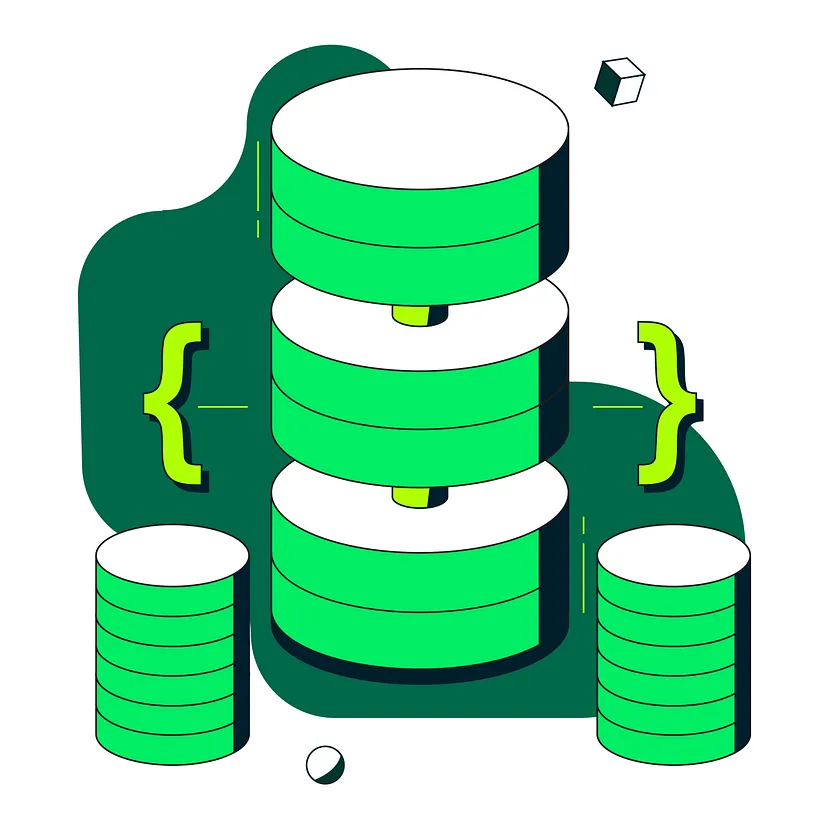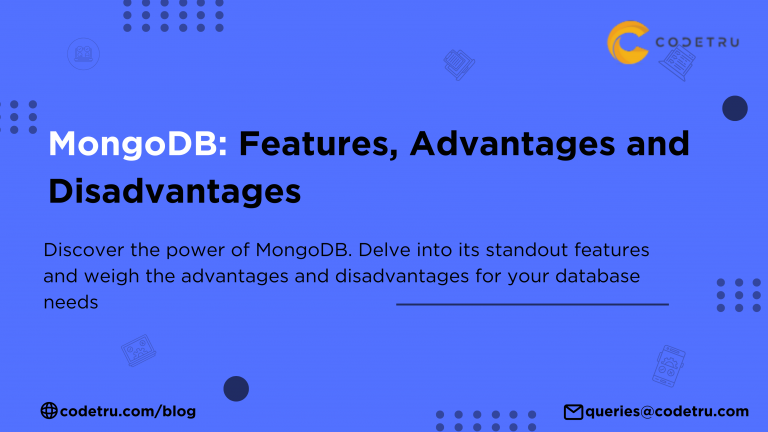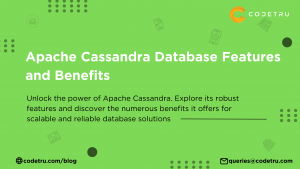MongoDB is the most popular NoSQL database, an open-source document-oriented database used for high volume data storage. This NoSQL database stores data in BSON format — a binary encoding JSON that stores data in key-value pairs.
Launched in the year 2007, MongoDB database is built for easy scalability, maximum availability, and good performance. Developers use this database to build apps quickly, as they don’t need to use stored procedures anymore. MongoDB also offers numerous options for maintaining the consistency of the data.
Features of MongoDB
MongoDB, written in C++ language, is a schema-less database that is more flexible than traditional tables. It has no schema to have many fields, content, and size different from another document in the same collection.
High Performance
MongoDB is an open-source database with superior performance. It upholds quicker query response in light of features like indexing and replication.
Document Oriented
MongoDB stores the main subject in a minimal number of documents and they are stored in a binary format called BSON. Every single document can be different with a varying number of fields. Further, the size of each document can be different from each other.
MongoDB Indexing
Indexing is very important for improving the performance of search queries. Without indexing, a database would need to examine each document of a collection to choose those that match the query, which would be inefficient. So for efficient searching, indexing is a must.
Sharding
MongoDB scales horizontally using sharding. Sharding is a process that distributes data across multiple physical partitions called shards. Sharding is used in cases where there is a need to work on very large datasets.
Replication
The replication feature is to distribute data to multiple nodes. There can be primary nodes and secondary nodes to replicate data. Replication of data is done using master-slave architecture. MongoDB gives a replication feature by appropriating information across different machines.
File Storage
MongoDB is considered the best file storage system. It utilizes load balancing and data replication features over numerous machines for storing files.
Why Use MongoDB?
MongoDB has been developed on a scale-out architectural format, thus making it easy for developers to work with, especially to craft apps with changing data schemas that can be scaled. This NoSQL database can save, manage, update, and extract data without hassles.
MongoDB has a dynamic and elastic schema, thus, adding and eliminating fields is very easy. As developers look after the schema, they can fine-tune and reformat it as the app progresses.
MongoDB is considered the pioneer among NoSQL databases that came into existence as SQL-based RDBMS. It provided little support for scaling and speedy development cycles which were necessary for creating sophisticated apps.
As MongoDB retrieves documents in JSON format, it is easily readable by humans; after all, it’s the natural form of data storage. The JSON format can be settled for putting away data objects that are intricate.
Moreover, data can be parsed quicker with the BSON format, which also enables indexing and searching to boost performance significantly. One can also use Text, partial, geospatial, decimal, and other varieties of indexing methods.
Where is MongoDB used?
Although MongoDB has wide application, it is more commonly used for the following:
- Building mobile & social infrastructure
- Managing & delivering content
- Managing user data
- Big Data
- Data Hub
Who’s Using MongoDB?

At present, MongoDB is being utilized as backend software by various significant websites and services including EA, Cisco, Shutterfly, Adobe, Ericsson, Craigslist, eBay, and Foursquare.
Language Support by MongoDB
MongoDB provides official driver support to some of the common programming languages including C, C++, Rust, C#, Java, Node.js, Perl, PHP, Python, Ruby, Scala, Go, and Erlang.
Important Terms Used in MongoDB
There are different terms used in the MongoDB NoSQL database. Some of the important terms used in the MongoDB database include the following:

Document: This is a record in MongoDB where data is stored in key-value pairs.
Collection: This is a group of documents.
Database: A database is a place where all the documents are present.
Key-value pairs: In MongoDB, data is stored in JSON format and JSON stores data in key-value pairs.
JSON: This is a data-interchange format used in MongoDB to store data.
BSON: This is an extended JSON that supports a variety of data types.
_Id: This is auto-generated whenever a document is created. The value of _id is unique.
Advantages of MongoDB
- MongoDB has been created in such a way that it ensures developers have an excellent experience while creating apps. What developers love about this database is that it can be used with a whole suite of languages like JavaScript, Java, Go, C#, Python, PHP, Swift, Scala, Rust, and Ruby on Rails.
- In MongoDB, new features are being added for supporting operations of MongoDB in Enterprise IT as more and more businesses are opting for this database.
- MongoDB customers receive excellent tech support.
- The MongoDB Atlas is available in the cloud, and thus using MongoDB has become even simpler.
- MongoDB Atlas has other robust capabilities, and that includes:
Search — Search allows for full-text search.
Realm — 100% managed server-side services for developing apps.
Data Lake — Data Lake enables query and combination of data that is stored in any HTTPS store or Amazon S3. - Scalability is another big advantage of MongoDB. One can develop apps that are capable of handling traffic spikes smoothly, thanks to the scale-out architecture feature that MongoDB has.
- Sharding in MongoDB allows storing huge data volumes by automatically distributing them to numerous servers.
- MongoDB can be horizontally scaled, and thus is great for handling huge data volumes.
- MongoDB receives advanced support for ad hoc queries.
- MongoDB can access documents by indexing, and provides a response to queries — is 100 times faster than a conventional RDBMS database.
- MongoDB can be used free of cost.
- The performance of MongoDB is very much higher as compared to any relational database.
- With MongoDB, there is no need for mapping application objects to database objects.
- As MongoDB uses internal memory storage, it enables faster access to the data.
- MongoDB developers have a huge vibrant community around the world in the open-source arena, academia, consulting firms, system integrators, and so on.
Disadvantages of MongoDB
Although MongoDB provides lots of advantages but also has some limitations. Following are a few disadvantages:
- MongoDB doesn’t support joins like a relational database. However, despite this, one can still use joins functionality by adding the code manually.
- MongoDB stores key names for each value pair. As there is no functionality of joins, there is data redundancy. We can restrict this by using other means.
- MongoDB offers a limited data size. With MongoDB, you cannot have a document size of more than 16MB.
- MongoDB offers limited nesting. With MongoDB, you cannot perform the nesting of documents for more than 100 levels.
FAQs About MongoDB
1. What is MongoDB, and what makes it different?
MongoDB is the first NoSQL database known to have document-oriented storage in BSON format, which is binary-encoded JSON. It stands out for its scalability, high performance, and flexibility in design, making it ideal for applications with growing data structures.
2. How does MongoDB handle data consistency and scalability?
MongoDB ensures data consistency through replication and supports horizontal scaling through sharding. Replication requires data to be distributed across multiple nodes with primary and secondary functions, while data is distributed across physical servers to efficiently manage large datasets
3. Where and who typically uses MongoDB?
MongoDB finds great usage in industries such as mobile infrastructure, content management, user data management, and big data applications. Major companies like EA, Cisco, Adobe, and eBay rely on MongoDB for its robustness and scalability in meeting data needs.
4. What are the advantages of using MongoDB over traditional SQL databases?
MongoDB offers advantages such as flexible schema, support for dynamic queries, faster data movement due to indexing, scalability to handle large amounts of data, and compatibility with multiple programming languages. It excels in scenarios where it is needed in agile development and real-time data processing.
What are the limitations or problems with MongoDB?
MongoDB limitations include lack of built-in integration like SQL databases, possible data redundancy due to denormalization, document size limit (up to 16MB), nesting limit (maximum nesting level up to 100). These factors should be considered when designing data models in MongoDB.







